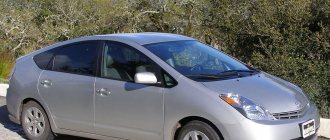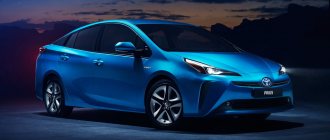“You could sow seeds in the trunk.”
– Prius was bought, essentially, by accident. In general, we initially considered the Peugeot 307 SW, but a friend talked us out of this car and suggested we look at the hybrid Toyota. According to him, this is an ideal option for my wife and I’s lifestyle and characters. At first we didn’t like it at all, but then we took a ride in a colleague’s car, saw how he once shoved a wardrobe into it, and were very impressed.
The car, produced in 2008, was purchased at the very beginning of 2017 with 112,000 kilometers on the odometer, now it has 170,000. Judging by the condition of the engine at the time of purchase, the mileage is similar to the real one: the engine was running, there was no oil loss and there is not now. The car then cost $7,500 and, judging by the advertisements, did not lose much in value.
Legend has it that the car was driven by a grandfather whose son brought it from France in 2014. Grandfather himself, according to him, used the car little due to vision problems, mainly for trips to the country in the summer. Our Prius drives mainly around the city, although at first there were regular trips to Europe.
After the purchase, the first thing I had to do was clean the car after my grandfather. All kinds of country tools were tinkered with in the trunk and interior, so it was possible to sow seeds there - they would probably germinate. We also immediately changed the tires, bought summer and winter sets, because the car had “dead” tires, and they were also different on the front and rear axles. Our European version has 16-inch wheels, while the American version has 15-inch wheels. In my opinion, on the American version the fuel pump and filter are also tightly built into the gas tank; they cannot be changed separately, but in the European version there is no problem with this.
My Prius
There is a misconception that the Toyota Prius is not suitable for winter and is effective only in countries with warm climates, that the traction battery freezes and quickly fails, and other horror stories and rumors.
This year was our first winter with a hybrid; I live in Khabarovsk in the Far East of Russia. Our climate is sharply continental monsoon. In summer the heat is over +35 with humidity under 90%, the same winters are minus only with wind and high humidity. This year the frosts reached -42 C, and for a couple of weeks the temperature stayed at -30. Many will say it’s not so much based on the minus numbers, they say, it can be colder. How to say. My relative from Chelyabinsk served conscript duty with us and remembers this past winter with a shudder. In his words, the frosts we have here are not right and the winter is not right.
And so back to the hybrid. There are no autostarts, pre-start boilers, thermoses or other shamanism on the car. The spark plugs are original from Japan - I did not replace them. Before winter, I only changed the engine and transmission oil. The antifreeze remained factory, I will write about it later. I didn't put the cardboard in front of the radiator.
Winter starting in temperatures down to -30 is just as easy as in summer, there is no difference. Warming up the car takes 5-7 minutes.
When frosts exceed -30, the morning start on the street happens the first time, but the operation of the gasoline engine after starting is accompanied by short-term knocking sounds, I assume due to the hydraulic chain tensioner, while the oil pressure rises in the system.
At frosts of -35 and below, you can already feel a decrease in the rotation speed of the gasoline engine at the moment of start. Well, what do you want when the oil reluctantly drains from the dipstick? Let me remind you that I use 5W30 oil, and let’s say for frosts above -30, an oil with a lower viscosity is recommended, but we only have such frosts for a week or two.
In the frost, as in the thermometer from the photo, which was minimal this year, namely -42 C. I came to the parking lot in the morning and after the usual recognition signal of the standard Smart key, the doors did not open - the lubricant in the central locking drives froze. I took the key out of the mark and barely turned the driver's door cylinder by hand. Opened the hood. I checked the oil dipstick, it is there, the dipstick itself is there, but the oil on the dipstick is shoe polish. If you suddenly see frozen water and oil on the dipstick in winter, don’t be alarmed, it’s condensation.
The key is to start, or rather I press the start button.
The first attempt - the motor rotates, but you can hear that the rotation speed is much lower than usual, by 20-30 percent. There are no flashes, the chain rattles. Scroll for 5-7 seconds. I turn it off with the button. I wait a couple of minutes for the fuel to evaporate in the manifold. I always fill up with Rosneft 92 gasoline, winter starting on it is worse than on the competing NK Alliance, but on Rosneft there are more liters and the price is lower.
Second attempt - turned on the car, a second delay - the startup started, 3-4 seconds there were no flashes. I keep spinning, or rather I watch how she spins herself. The rotation speed increased slightly, and flashes started at 5-7 seconds. Based on the experience of previous cars, I stop starting due to the risk of flooding the spark plugs. Access to the spark plugs on a Prius involves removing the plastic under the windshield wiper blades, removing the coils on the engine and filling them in the cold is the last thing.
Third attempt to start - waited three minutes, pressed the start button. Either it will start or the spark plugs will flood, I think, and I watch the start for 7-10 seconds until the engine starts working normally. At first intermittently, then better and better, the starting electric motor did not turn off until the gasoline engine reached operating mode. The READY light has stopped blinking and the main battery is charging.
A curtain!
On the forums I found a description of an even more extreme successful start in Khanty-Mansiysk with an outside temperature of -56, although “only” 4 times.
Now show me at least one example of a similar start “from the key” of a regular gasoline car under the same conditions.
Now a little theory:
The Prius engine may not start, but from the outside it will look like a running engine. The fact is that the Prius does not have a starter and the starting electric motor of 18 kW (for comparison, a regular 1 kW starter) will first spin up the gasoline engine at a speed of 1000 rpm and only then start, and only 2 cylinders take part in the start itself, and not 4 like on a regular engine. The startup process under normal conditions is instantaneous - it only takes one second! This is done specifically to soften the starting process and reduce engine wear. The maximum start attempt lasts 40 seconds. Throughout the entire start attempt, the READY light (ready to move) blinks. After a successful start, the READY light is constantly on.
Now you understand that with a starting electric motor of 18 kW, the issue of winter starts on the Prius is better than any other car. I think that using shoe polish instead of oil will turn and turn the crankshaft just right.
Prius winter start at -42 degrees
winter in Khabarovsk
Explanation for photos:
The on-board display on Priuses for the Japanese domestic market does not show temperatures below -30 C, keep this fact in mind for the future.
A key fob with a temperature of -39 shows the engine temperature of a nearby Mazda. Don’t take the thermometer off the window for photographic evidence.
As we can see, there is an error in temperature measurements, although on TV and on city thermometers on buildings that morning it was -42 C.
The first photo shows that after all 3 attempts to start, the battery has dropped to the minimum value of 2 bars, the engine is started, and the battery is charging.
For myself in winter, I have identified three basic rules of operation:
1) Leave the car overnight only with a charged main battery.
2) Start driving only after the gasoline engine has warmed up.
3) Do not load an unheated traction battery in severe frosts
On the first point - in the parking lot before turning it off, I set the climate control to maximum heat for constant operation of the gasoline engine and look at the energy distribution display; as soon as the battery stops accepting a charge, I turn off the car.
Regarding the second point - in view of the absence of any indicators of low coolant temperature, I am guided as follows: turn on the automatic climate control and wait for the supply of warm air to the cabin to begin. In automatic climate control mode, priority is given to warming up the gasoline engine. When excess heat appears, air supply to the cabin will begin.
Regarding the third point, the traction battery is located behind the rear seat, practically in the trunk, and warms up much later than the passenger compartment itself, although it is connected to an air duct for ventilation/heating from the passenger compartment with an air intake in the upper back of the rear seat. Therefore, in severe frosts after an overnight stay, you should not immediately load the traction battery with intense acceleration and forced activation of the electric vehicle mode. This applies more to operating conditions beyond -35 C. But I adhere to this rule all winter.
You can read about fuel consumption in winter here.
Entry published on 06/09/2011 at 16:14 and is filed under Operation and repair. You can read comments using the RSS feed. You can leave a comment, or send a trackback from your site.
“Antifreeze has to be changed every two years”
Naturally, all the main fluids were immediately changed: antifreeze, brake fluid and oil. Everything is the same as in a regular car, only you need more antifreeze - 7 liters. We also changed the oil in the planetary gearbox - filled it with Toyota ATF WS, but this cannot be called an additional expense, because cars with traditional manual and automatic transmissions also need to change the oil.
Antifreeze on the Prius 20 has to be changed regularly, once every two years, and it is advisable to use high-quality one, because if the inverter cooling pump fails, the inverter itself will follow it, and it is very expensive.
The spark plugs were also changed. Quite expensive iridium ones are used here - at the time of replacement the kit cost about 110 rubles. But fuel consumption dropped by half a liter. The spark plugs last for 70,000-80,000 kilometers.
Fuel consumption depends on driving style and operating conditions. In the city it is 5-5.5 liters per 100 kilometers, in winter it reaches six and even 6.5 if you drive short distances and stand at traffic lights a lot. On the highway, 4.5-5 liters are consumed at a speed of 90-120. On German autobahns, if you drive 150 kilometers per hour, it will increase to 7 liters per “hundred”.
The dynamics of the car feel like a two-liter petrol one. Here the internal combustion engine has a volume of one and a half liters, it is derated, the power is only 78 “horses” plus a 68-horsepower electric motor. In synergic mode, the power plant produces 113 horsepower, and the torque of the electric motor is 400 Newton meters, available from zero to 1250 rpm. Therefore, the car has enough dynamics, you can even leave traffic lights with a lead.
In winter there were no problems with starting. The main thing is to fill in the appropriate oil, I use PAO-ester. And many people advise changing the oil every 5,000 kilometers so that the thin oil scraper rings do not coke, which will lead to oil burns. Plus, the gasoline engine often turns off while driving, and if the oil has poor thermal stability, it begins to burn out. I had to learn this whole theory on specialized forums.
At 150,000 miles, it was time for the brake pads and discs, but it looked like this was their first replacement, since the car had original parts. Due to braking mainly by recuperation, the brakes in the Prius last a very long time.
At 120,000 kilometers one of the front hubs “died” - this is exactly its predicted life. Recently, at a mileage of 158,000, it was the turn of the second one. This is all, with the exception of the “consumables” that were changed in the car over 60,000 kilometers. For prevention, decoking was once done because there was a slight oil burn: 200-300 grams per 5,000 kilometers. After decoking, oil consumption became insignificant.
“The battery is not afraid of frost”
When looking for such a car, the first thing you need to pay attention to is the battery, since it is the most expensive thing that is in the Prius. A service center that repairs hybrids will check it without any problems. You can also view the battery capacity, cell spread and resistance using the ELM 327 scanner and Hybrid Assistant or Dr software. Prius. In our case, the battery was in very good condition and remains so to this day.
The battery here is nickel metal hydride. Unlike lithium on subsequent Prius models, it is not afraid of frost and does not burn. Or rather, a short circuit is, of course, possible, but if something happens there won’t be a “take everything and wait until it burns out” situation, since the automatic protection system should turn everything off.
There is an interesting operational nuance associated with the battery: in the summer, the car must have a working air conditioner, since the battery is cooled by air from the passenger compartment. It is undesirable to allow its temperature to rise above 40 degrees Celsius in order to avoid degradation. Using the programs mentioned above, you can set the battery cooling to turn on not by 40, but by 30 degrees, which will extend its life. You also need to make sure that the vents are not clogged or blocked if you carry anything in the back seat.
By the way, after this winter the air conditioner required attention for the first time: the radiator was rotten from the reagents. An original Denso radiator costs 340 rubles, a Chinese replacement costs 120-130.
The suspension is harsh, but strong. The interior is simple at first glance, but the quality of the materials is high, there are no squeaks or “crickets.” The seats are quite normal, but if you want more comfort, you can get from Lexus. There is enough space in the back; passengers who sometimes travel there do not complain about being cramped.
There is also enough trunk space, the only negative is the heavily littered rear window, which interferes with the transportation of large items. But this is a decision for the sake of aerodynamics.
Here, to improve aerodynamics, there are even special caps installed on alloy wheels. When we bought the car, one of the hubcaps was missing. In Russia they cost from 30 dollars apiece, and used ones. As a result, we found the kit in Vladivostok, paid a little more than $100 for it, and our friends brought it. One was installed on the car, the remaining three are in stock. Although, in fact, these caps could be easily removed, the standard “castings” could be sandblasted, painted, and drove beautifully – the difference in fuel consumption would hardly be noticeable.
Options and cost
The Japanese company Toyota has created three trim levels for the Prius.
The first one is basic. For 2021, the car in this configuration cost more than 26 thousand dollars. The model was equipped with an automatic climate control system, an audio system, a rear view camera, and an LCD touch screen. The seats are upholstered in fabric. The steering wheel is hydraulically reinforced. Numerous airbags (7 pieces) are responsible for safety.
A standard hybrid costs approximately 6 thousand more. At the same time, the Toyota Prius V demonstrates the following technical characteristics:
- The driver's seat is adjustable in several directions (6);
- heated front seats;
- 17-inch alloy wheels;
- fog lights;
- LED optics, etc.
An additional offer, which involves considerable expenses, is an optional package that provides for the installation of a panoramic electric sunroof and cruise control for the Toyota Prius.
There is also a package that includes a navigation system with voice or button control, satellite radio, infotainment system, Bluetooth, leather upholstery, solar panels, etc. Mud flaps are not included with the Toyota Prius V.
A Russian buyer can purchase a Toyota Prius V with excellent technical characteristics, including:
- "Elegance" - 1245 thousand rubles;
- “Prestige” - 1451 thousand rubles;
- "Lux" - 1595 thousand rubles.
Despite the high cost of the hybrid, the manufacturer claims the possibility of serious savings and a fairly quick payback for the car due to low fuel consumption.
“Probably, the car was in more than one accident”
There are many problems with the body on our example. But these problems concern our car specifically, since we did not pay enough attention to this issue when choosing. There were small paint blisters on the hood right away - nothing happened to them in four years.
There were also pockets of corrosion on the driver's door, which appeared to have been broken. After some time, it became clear that the car had a lot of painted elements; most likely, it had been in some kind of accident, and maybe more than one, since there was a noticeable difference in the quality of preparation and painting of different places. Today, those parts of the body that have been repainted do not look the best. If I had had a thickness gauge on hand during the inspection, I probably would not have bought this car. On the other hand, I don’t regret that it wasn’t there, because technically the car is in excellent condition.
Another problem hinting at the car’s accident past was the cracked sealant on the rear pillar. I noticed it when I saw water flowing into the trunk. The solution is simple: take body sealant, apply it to the problem area - several years have passed and nothing is leaking.
In the near future I’m going to work on the bodywork, as I plan to drive this car for several more years. She absolutely can’t stand the brain, sometimes it’s even boring with her, you sit and think: “What can I do with her?” Of course, there is a lack of a modern multimedia system and navigation, but this is not the biggest problem.
Hybrids in the Automotive Business ad database
Typical malfunctions of the Prius 30. Climate system I think that this article will help owners of Priuses in the 30 body, even if they do not repair the climate control system themselves (which is quite within the capabilities of every owner who knows how to hold a wrench in their hands), then at least it will be able to save a lot of money funds. So, a Prius in body 30 came from Yekaterinburg for repairs. The owner has only one complaint - the air conditioning does not work. Before coming to us, the client visited two official Toyota services in Yekaterinburg, which made two diagnoses that were mutually exclusive:
- in the first service he was told that “the air conditioning compressor was covered with a copper basin” (the cost of a new one with work is 116,000 rubles!). This figure made the hair on his head stand on end, and he decided to check the diagnosis at another Toyota service center (I can assume that the client was traveling from them and comparing the cost of a new Boeing 777 with the cost of an air conditioner).
— to his great surprise, the second service center said that the air conditioning compressor was working, but the owner needed to replace the inverter, in which the air conditioning control unit had burned out. The cost of the inverter with replacement is 184,000 rubles!
So the owner ended up in our Hybrid service so that we could make a final verdict on what was wrong with his car.
We considered the error:
Which Toyota diagnostician do you think was right? Did you think that both were wrong?
No. The second diagnostician turned out to be more advanced! He accurately determined that the air conditioning compressor was absolutely working. And he definitely determined that the fault was in the inverter!
But then he considered that the power module responsible for controlling the compressor motor had burned out in the inverter, and sentenced the owner to replace the inverter assembly. And then he was wrong!
Look at the following photo:
It was this small part (fuse) that caused the malfunction.
Replacing this fuse, as you can see in the next photo, does not present any difficulty for the average owner.
The cost of all work including the fuse was 2,000 rubles. What is called “feel the difference”.
PS To help the owners. The original number of this fuse is: 90982-11050
.
Gordeev Sergey Nikolaevich © Legion-Avtodata
(forum nickname - FERMER) Sverdlovsk region, Beloyarsky district, Kochnevskoye village, Sadovaya st., 33. +7 hybridservis.ru








